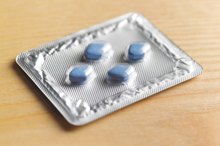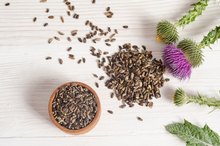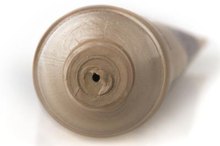What does fact checked mean?
At Healthfully, we strive to deliver objective content that is accurate and up-to-date. Our team periodically reviews articles in order to ensure content quality. The sources cited below consist of evidence from peer-reviewed journals, prominent medical organizations, academic associations, and government data.
- "Urology"; Tissue Effects of Saw Palmetto and Finasteride: Use of Biopsy Cores for In Situ Quantification of Prostatic Androgens; L. Marks, et al.; May 2011
- "Urology"; Tissue Effects of Saw Palmetto and Finasteride: Use of Biopsy Cores for In Situ Quantification of Prostatic Androgens; L. Marks, et al.; May 2011
- National Institute of Diabetes and Digestive and Kidney Disorders; Prostate Enlargement; Benign Prostatic Hyperplasia; June 2006
- "Phytomedicine"; A Comprehensive Review on the Stinging Nettle Effect and Efficacy Profiles. Part II: Urticae Radix; J. Chrubasik, et al.; August 2007
- "Phytomedicine"; A Comprehensive Review on the Stinging Nettle Effect and Efficacy Profiles. Part II: Urticae Radix; J. Chrubasik, et al.; August 2007
The information contained on this site is for informational purposes only, and should not be used as a substitute for the advice of a professional health care provider. Please check with the appropriate physician regarding health questions and concerns. Although we strive to deliver accurate and up-to-date information, no guarantee to that effect is made.
A Comparison of Saw Palmetto, Finasteride & Nettle
Benign prostatic hypertrophy, or BPH, is one of the most common disorders in men over age 60. It affects more than 50 percent of men over age 60 and 90 percent of those in their 70s and 80s, according to the National Institute of Diabetes and Digestive and Kidney Disorders. Symptoms include frequent nocturnal urination, a weak stream while urinating, urgency or dribbling. Prescription medications such as finasteride and herbal supplements such as saw palmetto and stinging nettle are used to treat BPH 1.
If you are experiencing serious medical symptoms, seek emergency treatment immediately.
5-Alpha-Reductase Actions
Saw palmetto, finasteride and stinging nettle all have different actions on the prostate 1. Finasteride, sold only by prescription, blocks the action of 5-alpha-reductase, an enzyme that changes testosterone, the dominant male hormone, to dihydrotestosterone, also called DHT 1. Saw palmetto blocks the conversion of testosterone to DHT by inhibiting 5-alpha-reductase activity. Saw palmetto also has inhibitory effects on male hormone receptors.
Stinging Nettle Effects
Finasteride 5Mg Side Effects
Learn More
Stinging nettle appears to have different actions; sex hormone binding globulin, or SHBG; aromatase; epidermal growth factor; and prostate steroid membrane receptors may all play a part in reducing BPH symptoms, which does not appear to have 5-alpha-reductase properties, according to a University of Freiburg report published in the August 2007 issue of “Phytomedicine.” Stinging nettle does not reduce the size of the prostate, like the other two drugs, but instead appears to decrease symptoms, possibly by affecting sex hormones or by acting directly on prostate cells. A combination of saw palmetto and stinging nettle is often used as an alternative treatment for BPH.
Results
Finasteride decreases prostate size by 20 to 30 percent in 6 to 24 months, according to Drugs.com 1. Clinical trials have shown mixed results for the benefit of saw palmetto when treating benign prostatic hyperplasia. According to the German article published by researchers from the University of Freiburg who conducted a review of literature, more confirmatory studies on the effects of stinging nettle are needed to prove its effectiveness
Comparisons
Finasteride and Acne
Learn More
A study conducted by the Urological Sciences Research Foundation in California compared the actions of finasteride and saw palmetto on prostate tissue 14. The results, reported in the May 2001 of “Urology,” found that both reduced DHT levels, indicating similar actions. The placebo drug had no effect.
Related Articles
References
- Drugs.com: Finasteride
- Memorial Sloan-Kettering Cancer Center: Saw Palmetto
- University of Maryland Medical Center; Stinging Nettle; Steven Ehrlich; February 2009
- "Urology"; Tissue Effects of Saw Palmetto and Finasteride: Use of Biopsy Cores for In Situ Quantification of Prostatic Androgens; L. Marks, et al.; May 2011
- "Phytomedicine"; A Comprehensive Review on the Stinging Nettle Effect and Efficacy Profiles. Part II: Urticae Radix; J. Chrubasik, et al.; August 2007
- Saw Palmetto. Penn State Hershey. Milton S. Hershey Medical Center. Health Information Library
- Saw Palmetto. Natural Medicines Database. Professional Monograph.
- Saw Palmetto. Memorial Sloan Kettering Cancer Center. About Herbs, Botanicals, and Other Products.
- Agbabiaka TB1, Pittler MH, Wider B, Ernst E. "Serenoa repens (saw palmetto): a systematic review of adverse events." Drug Saf. 2009;32(8):637-47.
- Gerber GS1. "Saw palmetto for the treatment of men with lower urinary tract symptoms." J Urol. 2000 May;163(5):1408-12.
- Gordon AE1, Shaughnessy AF. "Saw palmetto for prostate disorders." Am Fam Physician. 2003 Mar 15;67(6):1281-3.
- Morgia G1, Mucciardi G, Galì A, Madonia M, Marchese F, Di Benedetto A, Romano G, Bonvissuto G, Castelli T, Macchione L, Magno C. "Treatment of chronic prostatitis/chronic pelvic pain syndrome category IIIA with Serenoa repens plus selenium and lycopene (Profluss) versus S. repens alone: an Italian randomized multicenter-controlled study." Urol Int. 2010;84(4):400-6.
- National Institutes of Health. "Saw palmetto: MedlinePlus Supplements." February 2015.
- Prager N1, Bickett K, French N, Marcovici G. "A randomized, double-blind, placebo-controlled trial to determine the effectiveness of botanically derived inhibitors of 5-alpha-reductase in the treatment of androgenetic alopecia." J Altern Complement Med. 2002 Apr;8(2):143-52.
- Tacklind J1, Macdonald R, Rutks I, Stanke JU, Wilt TJ. "Serenoa repens for benign prostatic hyperplasia." Cochrane Database Syst Rev. 2012 Dec 12;12:CD001423.
Writer Bio
A registered nurse with more than 25 years of experience in oncology, labor/delivery, neonatal intensive care, infertility and ophthalmology, Sharon Perkins has also coauthored and edited numerous health books for the Wiley "Dummies" series. Perkins also has extensive experience working in home health with medically fragile pediatric patients.









